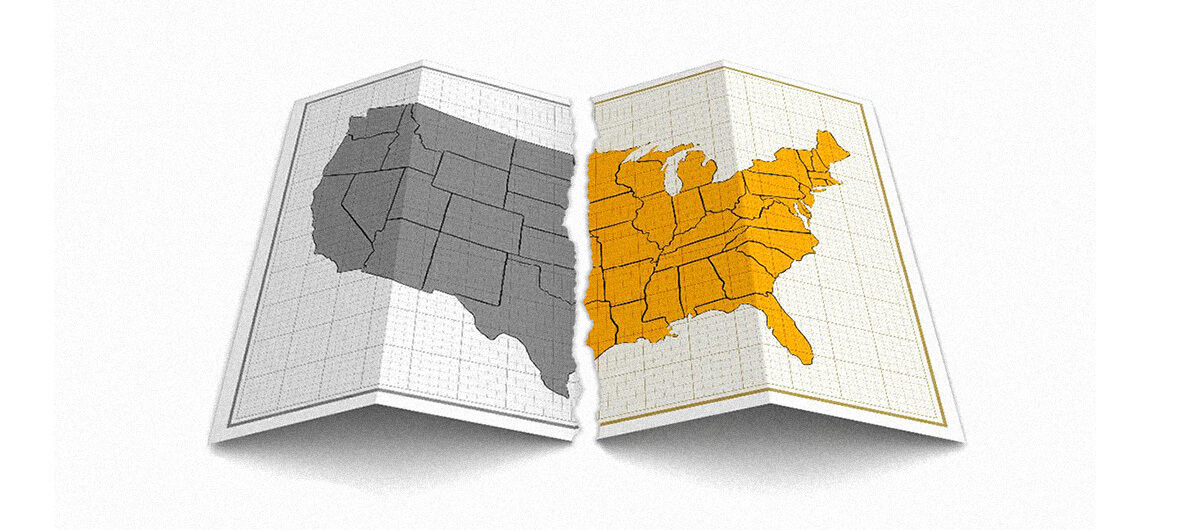 What would it take to spark internal conflict within the United States? What plausible scenario would cause a state, or states, to decide that it was worth the risk of conflict to secede?
What would it take to spark internal conflict within the United States? What plausible scenario would cause a state, or states, to decide that it was worth the risk of conflict to secede?
It seems like a ridiculous question. We all know how the Civil War turned out, that Abe Lincoln was a hero for preserving the Union, and that Southern states hadn’t gone that route anytime since despite desegregation.
However, this conversation was before the singularly implausible prospect of President Donald Trump.
The COVID-19 pandemic has laid bare the consequences of having a President who is not only incompetent, but also a pathological liar who is increasingly open about his autocratic tendencies. “When somebody’s the president of the United States, the authority is total,” he declared when threatening to force states to remove shelter in place orders and open for business. This sent a wave of dread down my spine: In the days after the 2016 election Masha Gessen’s rules for surviving autocracy reminded me that the first and foremost among them is “Believe the autocrat. He means what he says.”
This is essentially how autocracies happen in the modern era. The autocrat is elected once or twice, the courts are packed, power expanded, elections rigged in favor of the ruling party, and democracy is no more. It’s the model that has been followed in Russia, Turkey, and Hungary, and we’re tracking right down it. Some have seen this danger, but few have been willing to ask the more dangerous question: What does this look like from the perspective of a governor of a blue state?
Rudy Giuliani also spoke bluntly to this effect in an interview, “You know, when you play with your boss, sometimes it’s better if you don’t win the golf game. He’s the boss. He’s got all the resources.”
Blue states are also being discriminated against by the federal government in Covid-19 economic relief. Analysis by Bloomberg News revealed that over 70 percent of payroll loans under the Small Business Administration coronavirus relief program were being approved in deep-red states. In blue states like California and New York, the approval rate for loans was less than 25 percent. Representative Jackie Speier of California was succinct in her assessment of this disparity. “I smell a rat with orange hair,” she tweeted.
Governors in blue states have effectively given up on the federal government during the Covid-19 pandemic. J.B. Pritzker, the Democratic Governor of Illinois, summarized where he and other governors are. “We have gotten very little help from the federal government. It’s fine. I’ve given up on any promises that have been made.” Since the federal government under Trump has abrogated its responsibilities to the states, a consortium of Midwest governors have banded together to coordinate their own responses to the Covid-19 crisis. California, Oregon, and Washington formed another pact, as did states in the Northeast corridor. Notably, all of the governors participating are either Democrats, or Republicans who already have strained relationships with Trump, such as Mike DeWine of Ohio or Larry Hogan of Maryland.
While this might be interpreted at first glance as Trump taking a laissez-faire attitude towards governors, both his words and actions belie that notion. The Trump administration has been seizing shipments of personal protective equipment (PPE) to blue states, in what can only be assumed to be an attempt to undercut governors’ efforts to control the spread of the virus to medical personnel. Such actions directly endanger the lives of the people on the front lives of the pandemic, and states’ abilities to cope with it.
Previously, they attempted to block California and other blues states from enforcing their own emissions and pollution standards. His Department of Justice has repeatedly supported efforts to carve out vast religious exemptions to civil rights laws in blue states. Trump has also pulled federal funding from cities that do not fully cooperate with federal immigration authorities, and GOP-packed courts have upheld the move. Similarly, Trump threatened to cut off FEMA relief money to California after the devastating Camp and Woolsey fires, “unless they get their act together.”
More ominously, after AR-15 toting right-wing groups showed up protesting shelter-in-place orders at various capitals of states enforcing shelter in place orders, Trump tweeted “LIBERATE Michigan,” and “LIBERATE VIRGINIA, and save your great 2nd Amendment. It is under siege!” This appears to be a thinly veiled threat, or call to violence, against the democratically elected governments of states that are not sufficiently obsequious towards Trump.
A second Trump term, and the 7-2 majority on the Supreme Court it will bring far worse, some of which we can only imagine. Given near limitless power to interfere with the governance of blue states granted by the courts, one can only guess what mad whims and out-of-proportion punishments he would inflict on states that don’t do as they’re told.
Right-wing legal groups would see victories everywhere. Most civil rights laws would be undercut by vast religious exemptions. Employers will be able to opt-out of labor and civil rights laws based on their religious beliefs. The transgender military ban will be upheld, followed by the White House doing the exact same thing to lesbians and gays, granting hate groups what they are still agitating for. We’re likely to see a Supreme Court ruling that finds even the possibility of sharing a bathroom with a transgender person creates an intrinsically hostile (and illegal) environment, thus leading to a national transgender ban. The U.S. government will likely cease to recognize IDs issued by states to transgender people if there has been a gender marker change on the document. Obergefell, Windsor, and Lawrence are all likely to fall.
LGBT rights wouldn’t be enough to tip the scales, though. Neither will women’s health, despite how bad it will become. We’re likely to see Roe v. Wade not only overturned, but for groups like the Alliance Defending Freedom to build a body of case law and an argument which allows the Supreme Court to make abortion effectively illegal throughout the United States. They are also likely to make any sort of birth control beyond condoms very difficult, if not impossible, to obtain.
It’s also likely that the Federal government under Trump will attempt to use these newfound powers to interfere with elections, using the argument that the need for uniformity and national standards for elections and the FEC allow for this (although the exact arguments hardly matter in front of a court itching to rule in conservatives’ favor no matter what rationales are offered). These standards will, of course, ensure that as few Democrats as possible vote. Federally mandated voter-roll purges, and the unfathomable Supreme Court decision in favor of the Wisconsin Republicans forbidding extending mail-in ballot deadlines in the middle of a deadly pandemic, exemplify the sort of democracy-busting maneuvers that will become all too common.
Despite this parade of horribles, the breaking point is likely to come even sooner over immigration. The Trump administration dearly wants to begin mass deporting Dreamers early in a second term after the GOP-packed Supreme Court rules in their favor. Imagining this from the perspective of California Democrats: What happens to their political career if they allow 200,000 Californians to be deported to places where they do not speak the language, and are likely to die? For most, allowing this to happen would be antithetical to their values as well as political suicide.
In many ways, they will be making the same sorts of calculations the South was making in 1861. If Lincoln wins, can we accept the new normal that becomes inevitable? Is there any hope of winning back power politically and preserving our way of life? Is acquiescence to the inevitable political suicide? The South decided that no, they couldn’t live with the new normal. There was no hope of a political victory in their lifetimes and the Democratic convention of 1860 clearly showed that Democrats who tried to ignore the problem were doomed, even within their own party.
Also like 1861, once one state takes the plunge, it weakens the political positioning of all the remaining blue states, and encourages them to follow suit, like a dam bursting. This means that the risk is greater than one might surmise: It likely would only take pushing a single state over the edge in it’s decision-making process to cause all the others to follow suit.
However, there are several crucial differences between 1860 and today. More people are voting for Democrats than Republicans: It is only the non-proportional electoral college and Senate that has given Republicans enduring control, not an actual edge in voters. Blue states are the economic engine of America: districts won by Hillary Clinton in 2016 represented two-thirds of U.S. GDP. California would have the world’s fifth-largest economy if it were a nation. As a result, blue states provide the overwhelming majority of federal revenue, and get back much less than they put in. Red states, on the other hand, tend to get about twice as much as they put into the system. Financially, red states need blue states far more than the other way around.
Then there is the million-dollar question: how would Trump, and his base, react to moves by blue states exploring a divorce? Political hyper-polarization, and the Trump-fostered attitude that cities are festering cesspits of depravity, will push the GOP base towards an attitude of “good-riddance” rather than “the union must be preserved.” The only way Trumpists can accept blue regions as part of the U.S. is to gain power over them to stamp out the things they see as wicked, like abortion, undocumented immigrants, and LGBT people. Blue areas, conversely, are unlikely to accept these terms.
The Trump administration, for its part, seems determined to follow the desires of his white evangelical base to their logical conclusion: namely bringing blue states to heel, establishing permanent Republican dominance over the government and the courts, and re-establishing conservative Christian morality as a basis for law. His administration, the courts, and the religious conservative legal groups bringing impact litigation all seem dead-set on pushing blue states further and further into a corner. They assume that these states would never take the ultimate step of defying the federal government and seceding, rather than betraying their citizens and their morals. Every state has an unknown breaking point, and the Trump administration seems to be in a great rush to find exactly where it lies.
Fifteen years ago, the idea that states might be willing to consider whether they were better off outside the union was unthinkable. It is therefore staggering that today, if we continue down the path we’re on, there are plausible scenarios where these sorts of calculations will be made. A Trump victory in 2020 will test the assumption that states will put up with anything the federal government does in ways we haven’t seen since 1861.
The SCOTUS Event Horizon for the LGBT Movement

Stop for a moment. Imagine how bad it will be…